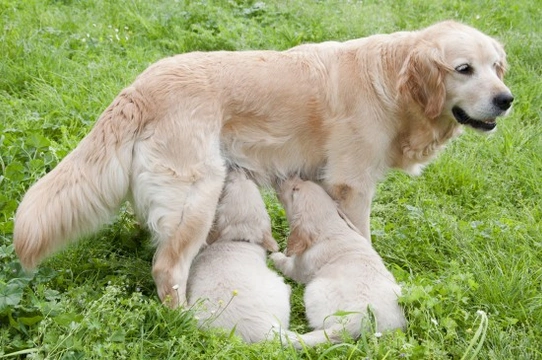Pets
Pets for studWanted petsBreedersAccessories & services
Knowledge hub
Support
Support & safety portal
Canine dam milk production and drying up timescales
Shortly before your pregnant dam delivers her pups, assuming that everything is well and the pregnancy and birth progress normally, your dam will begin to produce colostrum, and ultimately, the milk that will nourish the puppies through their first few weeks of life. As the pups grow and develop, they will take a progressive interest in eating the food that the dam eats, beginning with soft, wet food and ultimately moving on to age-appropriate meals, and rejecting milk altogether.
The length of time that this takes to happen can vary considerably from dog to dog, and as we tend to deliberately wean pups in preparation to go to their new homes, human intervention usually partially directs this process at the appropriate time. However, left unchecked and in the wild, the female dam nursing a litter will often continue to provide milk for her pups for a longer period of time, and the pups and adolescent dogs will often continue to nurse for several weeks, either until the dam’s milk dries up, or when she refuses to feed them anymore.
Read on to learn more about the natural timescale of the weaning process for pups, and how and when milk production in the dam begins and ends.
The natural process of milk production
The dam begins to produce colostrum shortly before the pups are delivered, and this highly nutritional fluid is thinner than milk, and will feed the pups for their first day or so in the world. After this, the colostrum thickens into true milk, to provide all of the calories and nutrients that the pups need to grow and develop normally.
Your dam will reach the peak level of her milk production at around the time that the pups are three to four weeks old, at which point the pups should begin to show an interest in enticing and palatable soft puppy food, and will begin to try out new tastes.
However, pups should not be weaned at this stage, and should continue to suckle from their dam as and when they wish to up until at least six weeks of age for medium and large breeds of dogs, or up to at least eight weeks of age for small breeds.
After this stage, the pups will have developed their taste for real food, and will seek out milk to a much lesser degree, at which point the volume of milk that the dam produces will begin to drop off.
Problems with milk production
A range of problems may mean that the dam does not begin to produce milk at the appropriate time, and this is particularly likely to be the case if the pups are delivered via caesarean section.
During natural birth, cervical stimulation provides the necessary cues to the body to begin milk production, and as this is bypassed when a caesarean is performed, it can lead to a delay in the milk’s descent into the teats. Generally, the pups attempting to seek milk and suckle is enough to prompt delayed milk production to begin, and this problem quickly corrects itself.
However, if the dam fails to begin to lactate at all, or if the milk dries up for no obvious reason before the pups are weaned, veterinary examination may be required, and ultimately, the pups may need to be hand fed.
When does milk production end?
When the pups first begin to explore eating solid food, the milk production of the dam will remain at a fairly high level initially, which causes the teats to become swollen and engorged with milk that is no longer needed in large quantities. Over time, the milk itself will dry up as it is no longer needed, and as the volume of milk production is affected not only by the pup’s need for it but by how much the dam eats, removing her food for a day on the day before the pups need to be fully weaned can help to dry up her milk supply entirely.
Once the pups are fully weaned and no longer seek out milk, or are removed from the dam so that they cannot seek out milk, milk production usually dries up within just a couple of days.
However, the tissues of the mammary glands are still primed and ready to supply milk for up to six weeks after weaning, and in a small number of cases, the dam will continue to produce milk during this time.
If the milk does not dry up
Just like birthing and caring for the pups during their first weeks of life, the drying up of the milk is generally a natural process that happens on its own at the appropriate time with no outside intervention required. However, if the dam continues to produce milk for a reasonable period of time after it is no longer needed, the dam will be at risk of developing mastitis, an infection of the glands of the mammary tissues that are responsible for producing milk.
Mastitis is caused by bacteria becoming established within the milk ducts of the teats, and may affect just one teat, all of them, or anything in between. Not only is this condition painful for the dam, but if pups nurse from infected teats, they too can contract infections, and so mastitis requires prompt veterinary attention.



